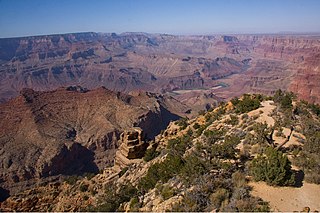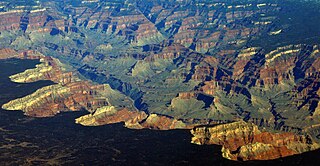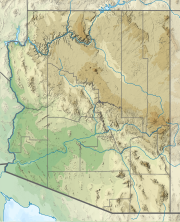
The Cambrian Muav Limestone is the upper geologic unit of the 3-member Tonto Group. It is about 650 feet (198 m) thick at its maximum. It is a resistant cliff-forming unit. The Muav consists of dark to light-gray, brown, and orange red limestone with dolomite and calcareous mudstone. The Muav is overlain in some areas by the Devonian Temple Butte Formation, but the major unit above, are the vertical cliffs of Mississippian Redwall Limestone. The Muav is located in the lower elevations of the Grand Canyon, Arizona.

The Cambrian Tapeats Sandstone is the lower geologic unit, about 230 feet (70 m) thick, at its maximum, of the 3-member Tonto Group. It is famous for being the highly-resistant mostly-horizontal unit above the 1,000 my, Great Unconformity expressed areally in the Grand Canyon of Arizona; also in other areas of Arizona and adjacent Nevada.

Temple Butte, in the Grand Canyon, Arizona, USA is a prominence below the East Rim. The butte lies on the west bank of the south-flowing Colorado River. The outfall from the Little Colorado River, draining from the Painted Desert to the east and southeast, is about 2-mi upstream.

Isis Temple is a prominence in the Grand Canyon, Arizona, Southwestern United States. It is located below the North Rim and adjacent to Granite Gorge. The prominence lies north of the north bank of the west-flowing Colorado River and is just north of Granite Gorge. The Trinity Creek and canyon flow due south at its west border; its north, and northeast border/flank is formed by Phantom Creek and canyon, a west tributary of Bright Angel Creek; the creeks intersect about 3 mi (4.8 km) southeast, and 1.0 mi (1.6 km) north of Granite Gorge. The Isis Temple prominence, is only about 202 ft (62 m) lower than Grand Canyon Village, the main public center on Grand Canyon’s South Rim.

Zoroaster Temple is a 7,123-foot-elevation summit located in the Grand Canyon, in Coconino County of Arizona, USA. It is situated 5.5 miles northeast of the Yavapai Point overlook on the canyon's South Rim, from which it can be seen towering over 4,600 feet above the Colorado River and Granite Gorge. Its nearest higher neighbor is Brahma Temple, less than one mile to the north-northeast. Zoroaster Temple is named for Zoroaster, an ancient Iranian prophet. This name was used by George Wharton James and Clarence Dutton. Dutton began the tradition of naming geographical features in the Grand Canyon after mythological deities. This geographical feature's name was officially adopted in 1906 by the U.S. Board on Geographic Names.
The first ascent of the summit was made by Rick Tidrick and Dave Ganci in September 1958 via the NE Arete (class 5.9+). Other climbing routes include Screaming Sky Crack, and SE Face, a challenging class 5.11+ route that was first climbed in 2012. The 1958 Zoroaster ascent was the first technical climb in the Grand Canyon, transforming the Grand Canyon into a climbing mecca and setting off a rush to climb the many summits. According to the Köppen climate classification system, Zoroaster Temple is located in a Cold semi-arid climate zone.

Angels Gate is a 6,761-foot (2,061 m)-elevation summit located in the Grand Canyon, in Coconino County of Arizona, United States. It is situated seven miles (11 km) due north of the Grandview Point overlook on the canyon's South Rim, three miles (4.8 km) west of Vishnu Temple, and three point five miles (5.6 km) southeast of Zoroaster Temple. Topographic relief is significant as it rises over 4,200 feet (1,300 m) above the Colorado River in three miles. Angels Gate is the place in Paiute mythology where the gods would return to earth by descending from the shadow world above. George Wharton James applied the "Angel Gate" name to this geographical feature in his book, In & Around the Grand Canyon, in 1900. This feature's name was officially adopted in 1906 by the U.S. Board on Geographic Names. Angels Gate has four peaks composed of Coconino Sandstone. The main highest summit and three spires are known as "Snoopy and his Doghouse" for a resemblance to Snoopy, and the first ascent was made April 1972 by Chuck Graf and Dave Ganci. According to the Köppen climate classification system, Angels Gate is located in a cold semi-arid climate zone.

The Howlands Butte, elevation 5,572 feet (1,698 m), is a minor butte in the southeast drainage of the very large Clear Creek drainage. Clear Creek is a medium length flowing creek, just upstream of the major Bright Angel Creek outfall into the Colorado River, Granite Gorge. The Howlands Butte was officially named in 1932 for brothers Seneca and Oramel G. Howland, members of the Powell Geographic Expedition of 1869. Just two days from the expedition's intended destination, the pair and William H. Dunn left the expedition, fearing they could not survive the dangers of the river much longer. They hiked out of the canyon and were never seen again. Separation Rapids on the river is where they departed from Powell.

Cope Butte is a 3,754-foot (1,144 m) prominence adjacent the course of the Colorado River, in the Grand Canyon and sitting on the south side of Granite Gorge. The butte is roughly 4.5 miles (7.2 km) northwest of Grand Canyon Village of the central Grand Canyon. The butte has a narrow, triangular footprint, and contains a northwest-by-south slightly arcuate ridgeline spire. The prominence is near the north terminus of the sharp ridgeline, and is composed of white Surprise Canyon Formation.

Dana Butte is a 4,964-foot (1,513 m) prominence,, adjacent the course of the Colorado River, in the Grand Canyon and sits on the south side of Granite Gorge. The butte is roughly 2.5 miles (4.0 km) north-northwest of Grand Canyon Village of the central Grand Canyon, and lies about 2.0 miles (3.2 km) due north of Pima Point.

O'Neill Butte is a 6,071-foot (1,850 m)-elevation summit located in the Grand Canyon, in Coconino County of northern Arizona, United States. It is situated 2.5 miles (4.0 km) east-northeast of Grand Canyon Village, one mile (1.6 km) northeast of Mather Point, and one mile immediately northwest of Yaki Point. Cedar Ridge connects O'Neill Butte with Yaki Point on the South Rim. Topographic relief is significant as O'Neill Butte rises 3,600 feet (1,100 m) above the Colorado River in two miles (3.2 km). Access to this prominence is via the South Kaibab Trail which traverses the east slope of the peak. According to the Köppen climate classification system, O'Neill Butte is located in a cold semi-arid climate zone.

The Alligator , is a 5,774-foot (1,760 m)-elevation summit, a large ridgeline butte, connected to, and below Mohave Point, approximately 1.5 miles (2.4 km) northwest of Grand Canyon Village, Grand Canyon. The ridgeline trends north, and the lower elevation cliff, the tail of the alligator, turns northwest. The Alligator landform is about 1.0 mile (1.6 km) from the west-flowing Colorado River, and Granite Gorge. The Alligator lies between the Monument Creek drainage, west, and the Salt Creek drainage, east, both short, south tributaries to the Colorado.

Cardenas Butte is a 6,281-foot-elevation summit located in the eastern Grand Canyon, in Coconino County of northern Arizona, Southwestern United States. Cardenas Butte is named for García López de Cárdenas, the first European to see the Grand Canyon. The butte is located on a dp orange-red ridgeline of the Supai Group, adjacent its higher elevation neighbor, Escalante Butte; both buttes are ~1.5 miles north-northwest of Navajo Point in far eastern South Rim, approaching the East Rim.
Cardenas Butte are drained on the east by Tanner Canyon, north to the Colorado River; the northwest of Cardenas Butte is drained northwest by Cardenas Creek, and north by an unnamed drainage. The Tanner Trail from Navajo Point, courses the east, upper ridges of Escalante, then Cardenas Butte, upon the Supai Group, until the trail drops down through the Redwall Limestone, at the Supai ridgeline terminus. Cardenas Butte and Escalante Butte have similar elevations, with Escalante about 300 ft higher, and westwards up the burnt-orange-red ridgeline.

Horseshoe Mesa is a 5,246-foot-elevation mesa-summit located in the eastern Grand Canyon, in Coconino County of northern Arizona, USA. It is located 1.5 mi south of the Colorado River and Granite Gorge; also 4 mi due-south of the Cape Royal overlook, and ~2.0 mi northwest from Grandview Point, of the East South Rim, Grand Canyon. The Grandview Trail descends to Horseshoe Mesa, then drops down to meet the, the Tonto Trail.

Swilling Butte is a 6,785-foot (2,068 m)-elevation ridgeline summit located in the eastern Grand Canyon, in Coconino County of northern Arizona, United States. The landform is in a group of nearby summits, Colter Butte, west, and Hutton and Duppa Buttes, east. All four buttes are at the north of the east-flowing Kwagunt Creek and Canyon drainage to the Colorado River. Swilling Butte is 3.0 miles (4.8 km) northeast of Atoko Point, East Rim of the Walhalla Plateau, and 4.0 miles (6.4 km) west of the (north)-East Rim, Grand Canyon; the south-flowing Colorado River is west and adjacent to the East Rim. Swilling Butte is a triangular-platform summit of bright-red, tall Redwall Limestone. Being a cliff-former, the Redwall is also a platform-former. The upper platform of the Redwall Limestone supports a remainder-debris of the Supai Group. Of the two lower units, no. 2 is a cliff-former, hard rocks (cliffs), of the Manakacha Formation; the slope-former,, the Watahomigi Formation, forms most of the Supai debris upon the Redwall. Below the Redwall Limestone are members of the Cambrian Tonto Group, the Muav Limestone and the slopes of the Bright Angel Shale.

The Battleship is a 5,850-foot (1,780 m)-elevation summit located in central Grand Canyon, in Coconino County of northern Arizona, United States. The ridgeline, Battleship landform forms part of the western border of Garden Creek Canyon, which contains the Bright Angel Trail down to the Colorado River, and across it to Phantom Ranch. The east border of Garden Creek Canyon is the South Rim, with the overlooks of Grandeur Point and Yavapai Point. The Battleship is 1.5 miles (2.4 km) northwest of Yavapai Point, 1.5 miles due-north of Grand Canyon Village, and roughly 2.0 miles (3.2 km) southwest of the Colorado River.

Hubbell Butte is a 6,740 ft-elevation summit located in the eastern Grand Canyon, in Coconino County of northern Arizona, United States. It is situated ~1.5 miles northeast of Cape Final. Hubbell Butte lies about 1.0 mile southeast of Siegfried Pyre, both prominences adjacent 2.0 miles east of the Walhalla Plateau. The butte is about 5.0 miles west of the Colorado River, as it flows south through Marble Canyon, and the butte lies in the Upper Lava Creek watershed.
Hubbell Butte is composed of Supai Group units, sitting upon Redwall Limestone cliffs. The west flank of Hubbell Butte is on a north section of Lava Creek, and is adjacent, north, to the ridgeline of Siegfried Pyre, with its prominence, and two adjacent sub-prominences.

Plateau Point is a 3,789 ft-cliff-elevation Point located in the Grand Canyon, Coconino County of northern Arizona, United States. It is about 3.0 miles north-northeast of Grand Canyon Village, and about 2.0 miles north of Grandeur and Yavapai Points, and below the South Rim. Plateau Point,, overlooks the outfall intersection of Garden Creek Canyon, and Pipe Creek Canyon, intersecting from the southeast from Mather and Yaki Points. The point is on the Tonto Platform, and is accessed by the short Plateau Point Trail, from the Tonto Trail, which crosses the west of the Plateau Point platform.

Mather Point is a 7,119 foot (2,170 m)-cliff-elevation Point located in the central Grand Canyon, Coconino County of northern Arizona, United States. It was named in honor of Stephen Tyng Mather, an American industrialist and conservationist.

Hermit Canyon is a north-trending canyon in western Grand Canyon, about 6.0 miles in length, below the South Rim. It is named for the Hermit who built Hermit Camp, at the Colorado River, Louis D. Boucher. Hermit Canyon's east flank is bordered by Pima Point of the South Rim, and Pima Point is ~2.0 from the Hermit Canyon midline. Pima Point is about 3.5 miles west-northwest of Grand Canyon Village, and the South Rim at Pima Point trends southward, as the start of Western Grand Canyon; it also marks the terminus of the West Rim Road.

Tuna Canyon is a short, high-angle, descending, narrow canyon in western Grand Canyon, below the North Rim. It lies across Granite Gorge in a region of four canyons, and a fifth smaller canyon, as the Colorado River courses westward around the Point Sublime, , ridgelines. The high-angle of Tuna Canyon, Tuna Creek, creates the Tuna Creek Rapids (Rapid) at the outfall. Tuna Canyon is a short canyon, nestled between the ridges, but just east is the very long drainage of Crystal Creek (Arizona), which drains from the Kaibab Plateau. The Crystal Rapid is adjacent upstream from the Tuna Creek Rapids.


























